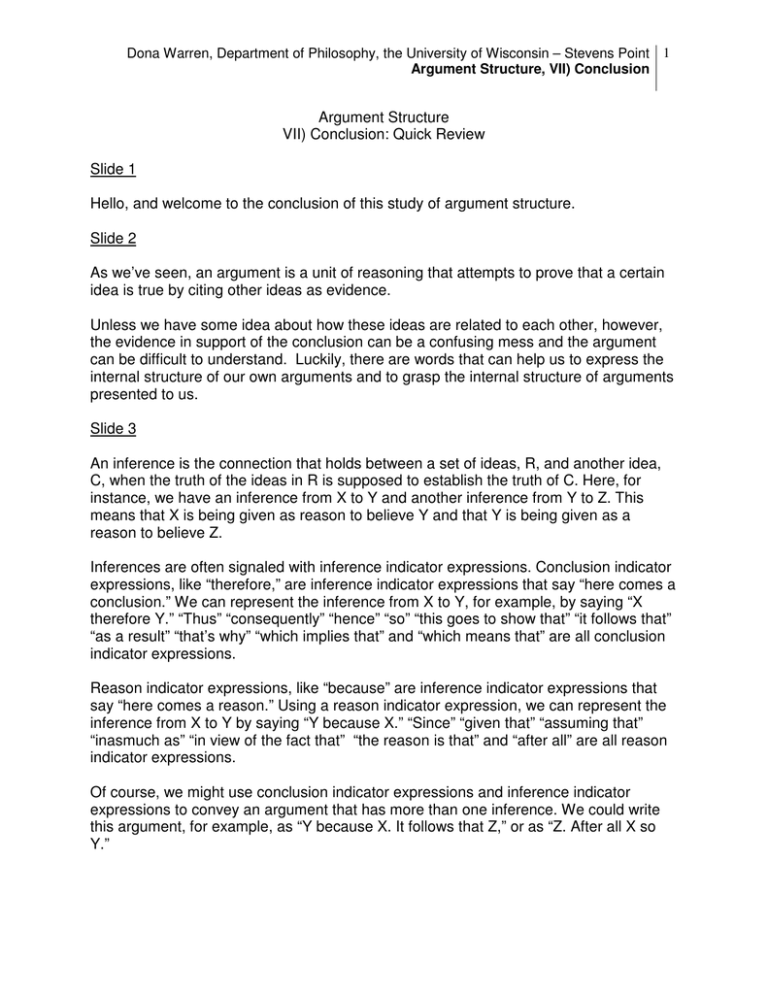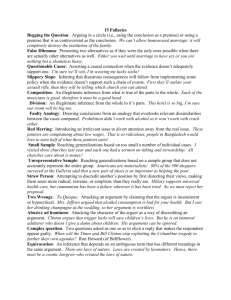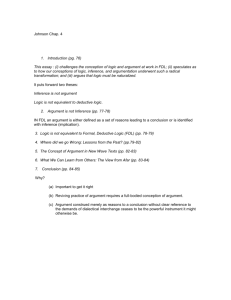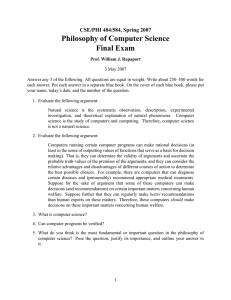Argument Structure VII) Conclusion: Quick Review Slide 1
advertisement

Dona Warren, Department of Philosophy, the University of Wisconsin – Stevens Point 1 Argument Structure, VII) Conclusion Argument Structure VII) Conclusion: Quick Review Slide 1 Hello, and welcome to the conclusion of this study of argument structure. Slide 2 As we’ve seen, an argument is a unit of reasoning that attempts to prove that a certain idea is true by citing other ideas as evidence. Unless we have some idea about how these ideas are related to each other, however, the evidence in support of the conclusion can be a confusing mess and the argument can be difficult to understand. Luckily, there are words that can help us to express the internal structure of our own arguments and to grasp the internal structure of arguments presented to us. Slide 3 An inference is the connection that holds between a set of ideas, R, and another idea, C, when the truth of the ideas in R is supposed to establish the truth of C. Here, for instance, we have an inference from X to Y and another inference from Y to Z. This means that X is being given as reason to believe Y and that Y is being given as a reason to believe Z. Inferences are often signaled with inference indicator expressions. Conclusion indicator expressions, like “therefore,” are inference indicator expressions that say “here comes a conclusion.” We can represent the inference from X to Y, for example, by saying “X therefore Y.” “Thus” “consequently” “hence” “so” “this goes to show that” “it follows that” “as a result” “that’s why” “which implies that” and “which means that” are all conclusion indicator expressions. Reason indicator expressions, like “because” are inference indicator expressions that say “here comes a reason.” Using a reason indicator expression, we can represent the inference from X to Y by saying “Y because X.” “Since” “given that” “assuming that” “inasmuch as” “in view of the fact that” “the reason is that” and “after all” are all reason indicator expressions. Of course, we might use conclusion indicator expressions and inference indicator expressions to convey an argument that has more than one inference. We could write this argument, for example, as “Y because X. It follows that Z,” or as “Z. After all X so Y.” Dona Warren, Department of Philosophy, the University of Wisconsin – Stevens Point 2 Argument Structure, VII) Conclusion Some arguments have dependent reasons, two or more ideas that are each unable to support a conclusion on its own but that can support the conclusion if taken together. In this argument, for instance, P and Q are dependent reasons in support of R. To signal that two ideas are dependent reason in support of a third, and if there’s no contrast or tension between the ideas, it’s a good idea to connect them with “and.” “Moreover,” “furthermore,” and “in addition” are also fine choices. If there is a contrast or tension between the dependent reasons, it’s a good idea to connect them with a “but.” “Yet,” “however,” “although,” “even though,” and “nevertheless” work as well. I sometimes call words like “and” and “but” “inference eraser expressions” because they have the function of saying that there is no inference between the ideas that they connect. Finally, some arguments have independent reasons, two or more ideas or groups of ideas that are each able to support a conclusion on its own. In this argument, for example, A and B are independent reasons in support of C. When an argument has independent reasons, it’s important to help people distinguish between them. A number of expressions can signal the introduction of an independent reason or a new line of reasoning, including “Besides,” “Furthermore,” “In addition to this,” “As if that weren’t enough,” “For one thing… For another thing…,” “First… Second… Third…,” and “Finally.” I call these expressions “theme changer expressions” because they serve to introduce a new line of reasoning, which will have its own theme. By taking advantage of all of these expressions, we can transform a messy and confusing argument Slide 4 into a neat and tidy one. We can even construct a diagram that displays the structure of the argument. Arguments analyzed in this way are much easier to understand than they were before. Of course, analyzing an argument can be tricky, even if we’re familiar with the expressions that we’ve just studied. In real life contexts, there are some things to look out for. Slide 5 Some ideas in the passage might not be part of the argument, for example. An idea is part of the argument only if it helps to support the ultimate conclusion, and quite frequently an author or a speaker will include ideas that serve some other function. These ideas should be ignored when you analyze the argument. Dona Warren, Department of Philosophy, the University of Wisconsin – Stevens Point 3 Argument Structure, VII) Conclusion Similarly, some ideas in the argument – some premises, subconclusions, and even the ultimate conclusion – might be unstated in the passage containing the argument. If it seems clear to you that an argument includes one of these ideas, it’s okay to supply the idea yourself. But be careful. You don’t want to commit the argument to a claim that it doesn’t really need. Some inferences might not be signaled with an inference indicator expression, like “therefore” or “because.” Some dependent reasons might not be signaled with inference eraser expressions, like “and” or “but.” And some independent reasons might not be signaled by theme changer expressions, like “besides.” What this means, of course, is that you can’t analyze an argument mechanically, without thinking. At this point, however, you have learned enough to start analyzing arguments on your own. Many people find it easiest to start by actually creating pen-and-paper diagrams for interesting or puzzling arguments that they encounter, so you might want to begin that way. Before you know it, however, you’ll start to see argument diagrams in your head, keeping track of the ideas as you go along, and that’s when these skills are at their most useful. Don’t push yourself, though. After you’ve worked through an argument or two, you’ll already be ahead of the game. Confusion is unavoidable and hurts. Thinking clearly takes work but feels good. Feel good.






